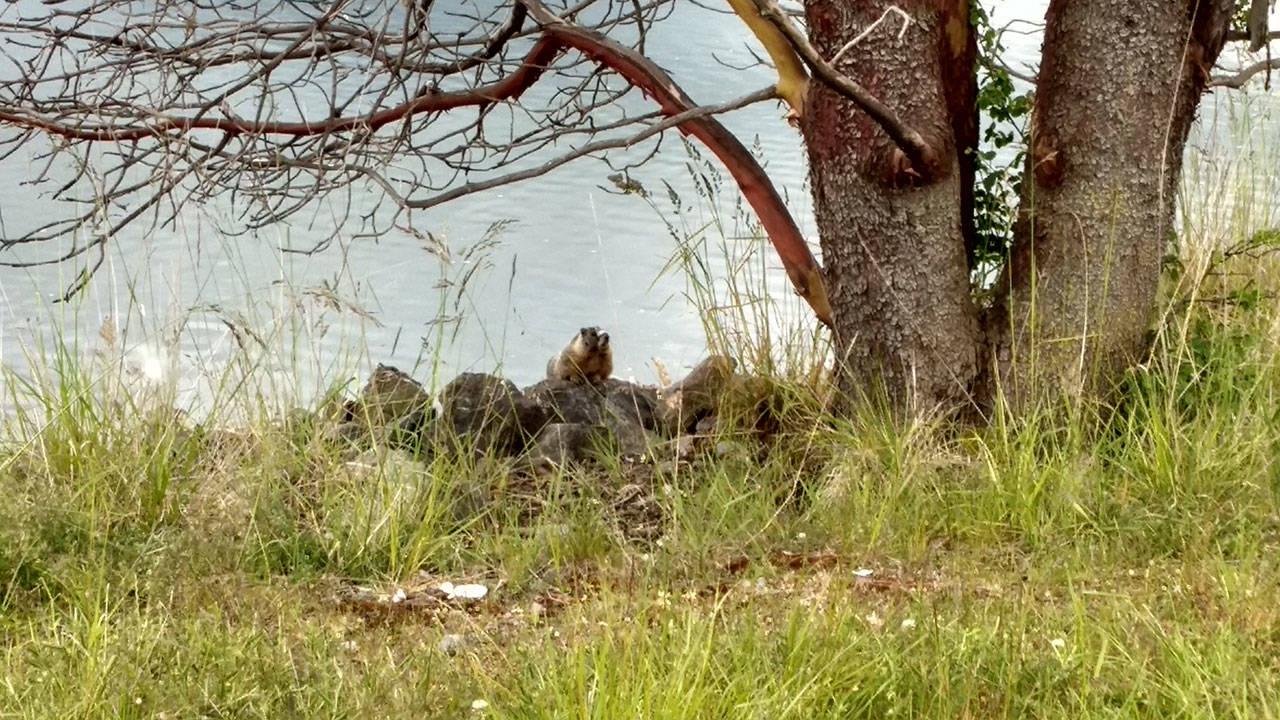More sightings of a non-native, yellow-bellied marmot reveal that more than one may have made Sequim its new home.
Locals took notice of one marmot, also called a rock chuck, along the Strait of Juan de Fuca in late March. Homeowners asked the specific location of the yellow-bellied marmot not be disclosed.
However, after a May 5 story ran in the Gazette about the marmot, locals report a dog chased it and it has not been seen since then.
After the story ran, Shanon Dell was reminded of a picture he took of a marmot near Washington Harbor and just east of Schmuck Road, in June of 2020.
Dell said he and friend Brian Marts haven’t seen it since, though.
Port Angeles photographer Richard Klawitter, who has snapped images of Olympic marmots in Olympic National Park since 1999, said he feels confident that Dell’s photo is a yellow-bellied marmot, too.
Its belly color, the white bar above its nose and shoulder and arm coloration fit the species, he said.
Previously, Klawitter found the March marmot sighting interesting because it was only one of three yellow-bellied marmot sightings in Western Washington in about a decade.
He found the sightings — including Dell’s — surprising because the marmots were spotted near water, and not in the dry and arid habitat they prefer in Central and Eastern Washington, he said.
Klawitter said a state resource manager reported to him another potential sighting of a yellow-bellied marmot occurred this month in Emerald Highlands off South Sequim Avenue.
He said the marmots normally travel about two-and-a-half miles but distances up to nine miles were recorded, making it possible that Dell’s photograph and the Emerald Highlands marmot are the same.
“So this is interesting,” Klawitter said. “We could be looking at one far-traveling animal or the possibility that these marmots are being transported to the peninsula at a rate that is not quite as rare as thought.”
Hitchhiker’s guide to marmots
Marmots of any kind aren’t common in the greater Sequim area, resource managers report with the Jamestown S’Klallam Tribe and Washington Maritime National Wildlife Refuge.
Previously, Klawitter said Olympic marmots have hitched rides off the mountain in tourists’ vehicles, so it’s not unlikely that yellow-bellied marmots came to the area in a vehicle, too.
Dr. Patti Happe, Olympic National Park’s wildlife biologist and wildlife branch chief, said via email that no other marmots, aside from Olympic marmots, are native to the park.
“To date, we are not aware of other species hitch-hiking a ride to the park,” she said.
Monitoring efforts for the Olympic marmot began in 2010 and continue this summer in the park with more than 100 volunteers signed up and nearly every trip full, reports Penny Wagner, the park’s public affairs specialist.
Read more here: nps.gov/olym/learn/nature/olympic-marmot-monitoring.htm.
Happe stated in a YouTube video for Washington’s National Park Fund that citizen scientists don’t count marmots individually because that’d be too difficult, but they survey habitats to see if marmots are there or not, also called occupancy tracking.
Sites are surveyed up to three times a year, she said.
While the 2020 report is not available online yet, the occupancy trend appears steady, Wagner said.
Annual surveys launched in 2010 because the Olympic marmots’ numbers were declining and park staff wanted to monitor habitat totals.



